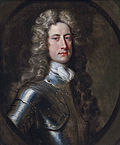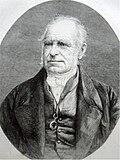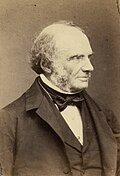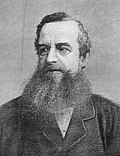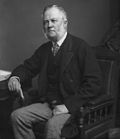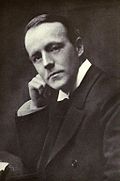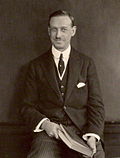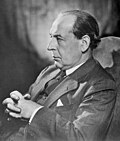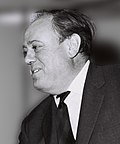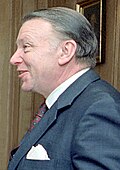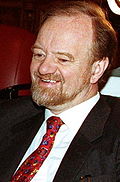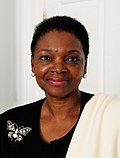Lord President of the Council
This article needs additional citations for verification. (May 2010) |
Privy Council of the United Kingdom Privy Council Office | |
|---|---|
| Style | The Right Honourable |
| Type | Great Officer of State |
| Appointer | The Sovereign on advice of the Prime Minister |
| Term length | At His Majesty's pleasure |
| Formation | 1530 |
| First holder | The 1st Duke of Suffolk |
| Salary | £159,038 per annum (2022)[1] (including £86,584 MP salary)[2] |
| Website | privycouncil |
| This article is part of a series on |
| Politics of the United Kingdom |
|---|
 |
|
|
The Lord President of the Council is the presiding officer of the
The office and its history
The Privy Council meets once a month, wherever the sovereign may be residing at the time, to give formal approval to
In the history of British government, the President of the Council is a relatively recent creation. The first certain appointment to the office being that of the Duke of Suffolk in 1529.
In the 19th century, the Lord President was generally the cabinet member responsible for the education system, amongst his other duties. This role was gradually scaled back in the late 19th and early 20th centuries but remnants of it remain, such as the oversight of the governance of various universities.
During times of
A particularly vital role was played by the Lord President of the Council during the
On several occasions since 1954, non-British Ministers have served briefly as acting Lords President of the Council, solely to preside over a meeting of the Privy Council held in a
Andrea Leadsom's appointment in June 2017 was the first in some time where the post holder was not a full Cabinet member.[15]
Role and responsibilities
Routine functions
"The Privy Council is the mechanism through which interdepartmental agreement is reached on those items of Government business which, for historical or other reasons, fall to Ministers as Privy Counsellors rather than as Departmental Ministers."[16]
The routine functions of the lord president are as follows:
- Preside at Privy Council meetings, including any emergency meetings, and attend to both ministerial correspondence and parliamentary questions relating to Privy Council business.[17]
- Consider for approval His Majesty's Government by Parliament for the purposes of creating detailed regulations through rulemaking.[23] Unlike prerogative orders, statutory Orders in Council are subject to parliamentary scrutiny.[24] As a consequence, most Orders in Council operate on statutory footing as opposed to the common law authorities conferred by the royal prerogative.[25]
- Consider for approval Orders of Council concerning various matters of state, namely appointments to and regulation of professional bodies and institutions of higher education. Unlike Orders in Council which are enacted by the sovereign on the advice of the Privy Council, Orders of Council are enacted by the Privy Council itself pursuant to statutory authority conferred by Parliament.[26][27][28]
- As a member of the Privy Council's Committee for the Affairs of Jersey and Guernsey, review laws passed by the bailiwicks of Jersey and Guernsey, and make recommendations to the sovereign concerning their approval.[29][30]
Visitorial functions
In addition to his or her routine functions, the lord president also serves as the visitor for several English universities, including:[31]
- University of Birmingham
- University of Bristol
- University of Hull
- Imperial College London
- Keele University
- University of Leeds
- University of Leicester
- University of Liverpool
- University of London (but not King's College London or University College London)
- University of Nottingham
- University of Reading
- University of Sheffield (but not Sheffield Hallam University)
- University of Southampton
- University of Sussex
- University of Wales
Partial list of Lords President of the Council
Lords President of the Council (c. 1530–1702)
| Lord President | Term of office | ||
|---|---|---|---|

|
Charles Brandon 1st Duke of Suffolk |
1530 | 14 August 1545 |

|
William Paulet 1st Marquess of Winchester |
January 1546 |
February 1550 |

|
John Dudley 1st Duke of Northumberland |
February 1550 |
July 1553 |

|
Henry Montagu 1st Earl of Manchester |
September 1621 |
July 1628 |

|
James Ley 1st Earl of Marlborough |
July 1628 |
14 December 1628 |

|
Edward Conway 1st Viscount Conway |
14 December 1628 |
3 January 1631 |

|
Anthony Ashley-Cooper
1st Earl of Shaftesbury |
21 April 1679 |
15 October 1679 |

|
John Robartes 1st Earl of Radnor |
24 October 1679 |
24 August 1684 |

|
Laurence Hyde 1st Earl of Rochester |
24 August 1684 |
18 February 1685 |

|
George Savile 1st Marquess of Halifax |
18 February 1685 |
4 December 1685 |

|
Robert Spencer 2nd Earl of Sunderland |
4 December 1685 |
October 1688 |

|
Richard Graham 1st Viscount Preston |
October 1688 |
December 1688 |

|
Thomas Osborne 1st Duke of Leeds [nb 1] |
14 February 1689 |
18 May 1699 |
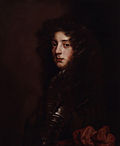
|
Thomas Herbert 8th Earl of Pembroke |
18 May 1699 |
29 January 1702 |

|
Charles Seymour 6th Duke of Somerset |
29 January 1702 |
13 July 1702 |
Lords President of the Council (1702–present)
- ^ Marquess of Carmarthen from 1689, created Duke of Leeds in 1694
- ^ Served as Secretary of State for the Northern Department from February 1721
- ^ Served as Secretary of State for the Northern Department from November 1744
- ^ Lord Lieutenant of Ireland from December 1750
- Earl Camden and Viscount Bayham in 1786[32]
- ^ Lord Privy Seal until February 1798
- ^ Earl of Ripon and Earl de Grey from 1859; created Marquess of Ripon in 1871[33]
- ^ Served Leader of the House of Lords until August 1876
- ^ Served as Lord Lieutenant of Ireland from May 1882
- ^ Served as Lord Privy Seal until March 1885
- ^ Served as Secretary of State for War from January 1886
- ^ Served as President of the Board of Education March 1900 – July 1902
- ^ Served as Leader of the House of Lords from July 1902
- ^ Served as Secretary of State for India March 1911– May 1911
- ^ Served as President of the Board of Trade from August 1916
- ^ MP for City of London until 1922; thereafter created Earl of Balfour and Viscount Traprain and joined the House of Lords[34]
- ^ Served as Chancellor of the Duchy of Lancaster until May 1923
- ^ Served as Lord Privy Seal September 1932 – December 1933
- ^ MP for Seaham until 1935; returned to Parliament as MP for Combined Scottish Universities in 1936[35]
- ^ Served as Secretary of State for Foreign Affairs from February 1938
- ^ MP for Lewisham East until 1950; MP for Lewisham South thereafter.[36]
- ^ Viscount Hailsham until 1963 when disclaimed under the Peerage Act 1963; returned to Parliament as MP for St. Marylebone in 1963[37]
- ^ Served as Leader of the House of Lords until October 1963
- ^ Served as Minister for Science from October 1963 – April 1964
- ^ Served as Secretary of State for Education and Science from April 1964
- ^ With special responsibility for political and constitutional reform
Timeline

See also
- Privy Council Office
- Vice-President of the Executive Council
- President of the King's Privy Council for Canada
- Sinecure
References
Citations
- ^ "Salaries of Members of His Majesty's Government – Financial Year 2022–23" (PDF). 15 December 2022.
- ^ "Pay and expenses for MPs". parliament.uk. Retrieved 15 December 2022.
- ^ "Privy Council: Guide to its origins, powers and members". BBC News. 8 October 2015. Retrieved 1 January 2018.
The body convenes, on average, about once a month and its meetings – known as councils – are presided over by The Queen.
- ^ Fryde, E. B. (1986) [1941]. Handbook of British Chronology. Cambridge: Cambridge University Press.
- ^ An Act that the President of the King's Counsel shall be associate with the Chancellor and Treasurer of England, and the Keeper of the King's Privy Seal.
- ^ "Sword of State – the Coronation Roll".
- ISBN 9781316515327.
- ISBN 9-781526-145451.
- ^ Hennessy, Peter. The Prime Minister: The Office and Its Holders Since 1945 (2000), pp.189–190.
- ^ Hennessy, p.191
- ^ Hennessy, p. 193
- Viscount Samuel (18 May 1954). "Her Majesty's Return". Parliamentary Debates (Hansard). Vol. 187. House of Lords. col. 645.
... there has been constitutional work done, there have been acts of State: ... meetings of the Privy Council, an organ of the Constitution older than Parliament itself, for wherever the Sovereign is, and three Privy Counsellors are present, there may be meetings of the Council and Orders passed. So, during this tour there have been sessions of the Privy Council in Australia, in New Zealand and in Ceylon, with their own local Privy Council members – members of the one single Imperial Privy Council, but their own local members.
- ^ Cox, Noel (1998–1999). "The Dichotomy of Legal Theory and Political Reality: The Honours Prerogative and Imperial Unity". Australian Journal of Law and Society. 1 (14): 15–42. Retrieved 19 November 2011.
The Queen has in fact regularly presided over meetings of the Privy Council in New Zealand, since her first in 1954. That was the first held by the Sovereign outside the United Kingdom, although in 1920 Edward Prince of Wales held a Council in Wellington to swear in the Earl of Liverpool as Governor-General.
- ISBN 978-1-877347-37-5. Archived from the original(PDF) on 11 January 2012. Retrieved 19 November 2011.
The Queen held a meeting of the Privy Council [on 13 January 1954] at the 'Court at Government House at Wellington' with her New Zealand prime minister as 'acting Lord President' of the council. The deputy prime minister, Keith Holyoake, 'secured for himself a place in constitutional history by becoming the first member to be sworn of Her Majesty's Council outside the United Kingdom'.
- ^ "Election 2017: Prime Minister and Cabinet appointments". GOV.UK. 11 June 2017. Retrieved 9 September 2017.
- ^ "Landing Page – Privy Council Office". Retrieved 27 December 2023.
- ^ "Lord President". Privy Council Office. Retrieved 27 December 2023.
- ^ "Meetings & Orders". Privy Council Office. Retrieved 27 December 2023.
- ^ David Torrance (14 September 2023). "What are Orders in Council". House of Commons Library. Retrieved 27 December 2023.
- ^ "About the Privy Council". Privy Council Office. Retrieved 27 December 2023.
- ^ "High Sheriffs". Privy Council Office. Retrieved 27 December 2023.
- JSTOR 2187027. Retrieved 27 December 2023.
- ^ Richard Kelly (15 December 2016). "House of Commons Research Paper: Statutory Instruments". Retrieved 27 December 2023.
- ^ "What is a Statutory Instrument". Public Law Project. Retrieved 27 December 2023.
- ^ "About the Privy Council". Privy Council Office. Retrieved 27 December 2023.
- ^ "About the Privy Council Office". Privy Council Office. Retrieved 27 December 2023.
- ^ "Professional bodies". Privy Council Office. Retrieved 27 December 2023.
- ^ "Higher education". Privy Council Office. Retrieved 27 December 2023.
- ^ "Committees". Privy Council Office. Retrieved 27 December 2023.
- ^ "Channel Islands". Privy Council. Retrieved 27 December 2023.
- ^ "Universities". Privy Council. 1 January 2005. Archived from the original on 9 September 2017. Retrieved 9 September 2017.
- ^ "No. 12750". The London Gazette. 9 May 1786. p. 201.
- ^ "No. 23748". The London Gazette. 20 June 1871. p. 2847.
- ^ "No. 32691". The London Gazette. 5 May 1922. p. 3512.
- ^ "No. 15252". The Edinburgh Gazette. 4 February 1936. p. 134.
- ^ "No. 39372". The London Gazette. 30 October 1951. p. 5663.
- ^ "No. 43180". The London Gazette. 10 December 1963. p. 10099.
Sources
- Chisholm, Hugh, ed. (1911). "Lord President of the Council". Encyclopædia Britannica (11th ed.). Cambridge University Press.















